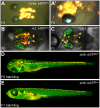CCTop: An Intuitive, Flexible and Reliable CRISPR/Cas9 Target Prediction Tool
- PMID: 25909470
- PMCID: PMC4409221
- DOI: 10.1371/journal.pone.0124633
CCTop: An Intuitive, Flexible and Reliable CRISPR/Cas9 Target Prediction Tool
Erratum in
-
Correction: CCTop: An Intuitive, Flexible and Reliable CRISPR/Cas9 Target Prediction Tool.PLoS One. 2017 Apr 20;12(4):e0176619. doi: 10.1371/journal.pone.0176619. eCollection 2017. PLoS One. 2017. PMID: 28426791 Free PMC article.
Abstract
Engineering of the CRISPR/Cas9 system has opened a plethora of new opportunities for site-directed mutagenesis and targeted genome modification. Fundamental to this is a stretch of twenty nucleotides at the 5' end of a guide RNA that provides specificity to the bound Cas9 endonuclease. Since a sequence of twenty nucleotides can occur multiple times in a given genome and some mismatches seem to be accepted by the CRISPR/Cas9 complex, an efficient and reliable in silico selection and evaluation of the targeting site is key prerequisite for the experimental success. Here we present the CRISPR/Cas9 target online predictor (CCTop, http://crispr.cos.uni-heidelberg.de) to overcome limitations of already available tools. CCTop provides an intuitive user interface with reasonable default parameters that can easily be tuned by the user. From a given query sequence, CCTop identifies and ranks all candidate sgRNA target sites according to their off-target quality and displays full documentation. CCTop was experimentally validated for gene inactivation, non-homologous end-joining as well as homology directed repair. Thus, CCTop provides the bench biologist with a tool for the rapid and efficient identification of high quality target sites.
Conflict of interest statement
Figures



References
Publication types
MeSH terms
Substances
LinkOut - more resources
Full Text Sources
Other Literature Sources
Research Materials

